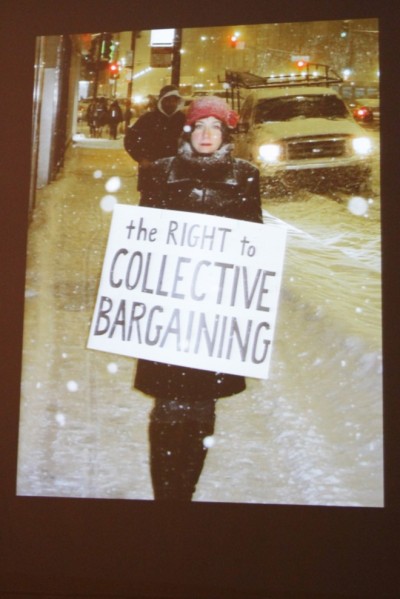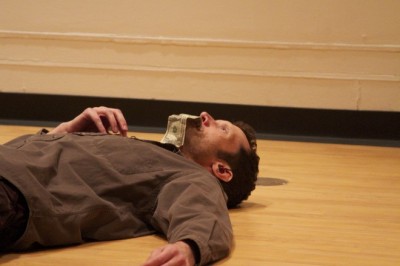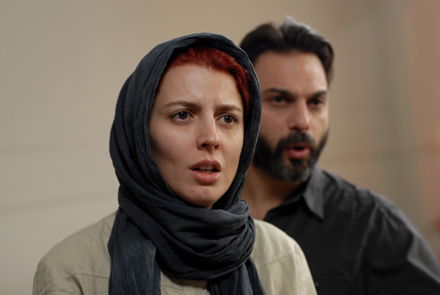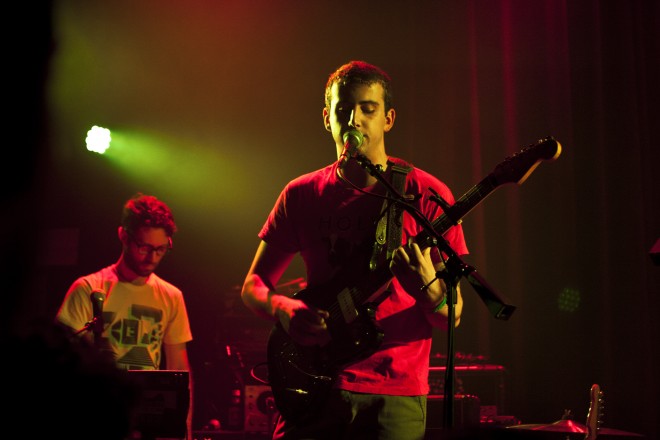Developed in the 1960s, the concept of Performance Lecture emerged as a sub-genre of Performance Art, concerned with the relationship of art and knowledge. The medium, offering space for conversation, debate, and explicit critique, has had notable practitioners, including Yvonne Rainer, Joseph Beuys, Robert Smithson, Chris Burden, and Andrea Fraser. However, in his introduction, artist and SAIC Professor Roberto Sifuentes cited older inspirations for the day’s format, including the Surrealist game of Exquisite Corpse, a drawing or writing exercise in which one artist begins a composition and passes it along for the next to continue. In the following reaction to SAIC’s Performance Symposium held on February 24, it felt appropriate to use the same structure, blurring the boundaries between individual contributors and allowing for creative potential through collaboration. Our aim is to accomplish this collaborative spirit by weaving together “intervention” and “panel” performances, in many cases using the words of the performers. Through this method, we hope to draw from all the invaluable sources present at the long and fertile symposium and, perhaps, raise new meanings through conflation.
[static file=”spout”]
Panel #1
Lisa Vinebaum: “New Demands?” Peter Carpenter: “Rituals of Abundance for Lean Tomes: Lecture Experiment” Irina Botea & Ruth Margraff: “Quick Reply”
“...wearing or just holding one of those signs and standing in front of the projection screen.”– Lisa Vinebaum
Intervention #1
Anthony Romero & Jillian Soto (Escape Group):
“Re)collecting Evidence”
“We will, in tandem, fight each other’s fights and also call out from behind hiding places for a familiar voice to echo our concerns. I am just asking that you entertain the idea of...”– Jillian Soto

Embracing the collaborative nature of performance lecture and launching the first panel, Lisa Vinebaum asked audience members to hold five signs bearing slogans she has used or will use in the future, while she discussed collective action across cultures and time periods. A particularly flamboyant sign-holder wagged his message back and forth, highlighting the presence of individuality in Vinebaum’s series of projects. In her slideshow, Vinebaum stood alone, a rogue activist without an apparent community. She seemed to float — a free-agent in advocacy of a range of disenfranchised peoples. Her lecture touched on groups ranging from migrant workers at a meat factory to garment workers and radical Jews in Montreal during the mid-twentieth century, for whom Vinebaum carries forth a legacy.
In response to demonstrations in Wisconsin protesting the state legislature’s revocation of the right to collective bargaining for public employees in March of 2011, the artist performed a series of “vigils” in Montreal, carrying signs in Yiddish that paralleled those of the public workers in the Midwest that stated, “stop the attacks on worker’s rights.” With this gesture, she connected a contemporary struggle to that of a different time. In a photograph, alone again on the street, Vinebaum seemed isolated in the precarious and vulnerable position of those who have lost their ability to congregate in support of their rights, either through laws prohibiting collective action, or the rupturing force of time.

Continuing the exploration of the isolated individual engaged in a moral struggle with forces of change, Peter Carpenter danced into a frenzy while discussing myths of scarcity due to inequitable distributions of resources. Muffled by a dollar bill in his mouth, Carpenter asked, “what can one, white, queer, male, middle-aged choreographer of the intellectual working class do to resist the omnipresent call of late capitalism to consume?” Destabilizing and making more volatile Steve Paxton’s “Small Dance,” which encourages its performers to find the place of least effort in order to maintain a vertical body, he viscerally brought issues of labor into the center of the work. His gesticulations spoke to both the individual’s loss of location in “the great global, multinational and de-centered human communication network” and of Carpenter’s own physical exertions.
Having previously outsourced the labor necessary to perform his choreography to dance companies and performers, he asked, “Can I do what I ask my dancers to do?” By reengaging with his own means of production, the artist also asked the audience to consider how individuals might reconnect with the “global stage,” becoming more than “mere consumers in a neoliberal hyperspace.” Like Vinebaum, he made a plea for community engagement through the use of his individual body.

Next, Irina Botea and Ruth Margraff took the stage with a less corporal look at the individual in relation to the community. The artists read excerpts from an email exchange — Botea drew from messages sent to a Romanian protest movement’s email and Margraff “quick replied” with musings on her experience with demonstrations in Spain. Botea’s practical dispatches (“It was -10 degrees C in the square today; It is the 16th day of revolt”) contrasted Margraff’s more poetic responses (“The moderator was changing all the time and I was struck by how theatrical that was”). The effect was a wonderfully stilted conversation between organizer and artist, who never disagreed, but talked past one another. They were inspired by QR (Quick Reply) codes that urge immediate engagement. Technology reared its head in this panel, only to take center stage as the symposium continued.







